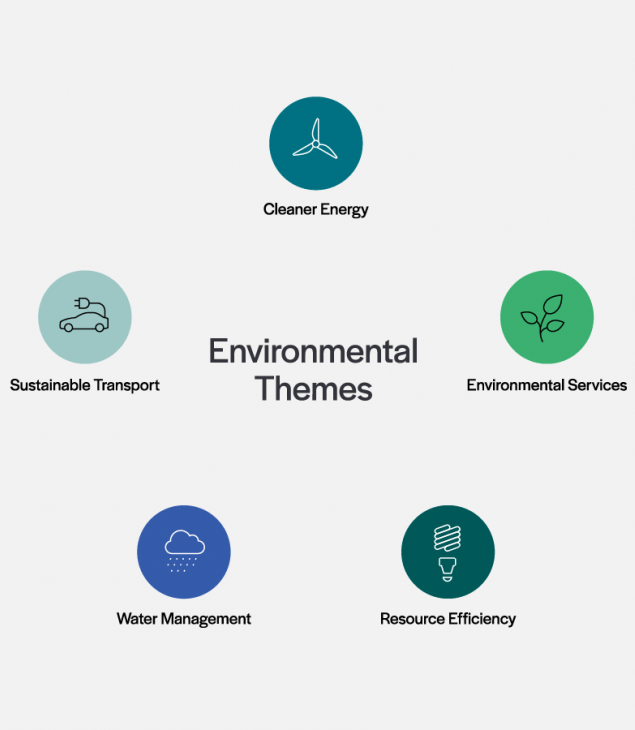
Net-Zero Carbon at WHEB
What is Net-Zero Carbon (NZC)?
NZC means cutting all greenhouse gas (GHG) emissions to as close to zero as possible, with any remaining emissions reabsorbed from the atmosphere, by oceans and forests for instance.
(NZC is different to carbon neutral because carbon neutral can cover a defined part of business operations and typically accounts only for CO2 emissions, but not other greenhouse gases. NZC on the other hand means that a company reduces all greenhouse gas emissions across its whole supply chain.)
Why does it matter?
In order to avoid the worst impacts of climate change and maintain a liveable planet, global temperature increase needs to be limited to 1.5°C above pre-industrial levels. The earth’s atmosphere is already about 1.1°C warmer than it was in the late 1800s, and emissions continue to rise.
How does our strategy contribute to NZC?
Five of WHEB’s investment themes are focused on companies that sell products or services that enable other parts of the economy to reduce GHG emissions and/or adapt to inevitable climate change. This includes companies that manufacture renewable energy equipment, components for battery electric vehicles, heat pumps and other technologies that improve energy efficiency and reduce resource use.
WHEB portfolio NZC targets
Portfolio Scope 1 and 2 emission targets and reductions
The Scope 1 and 2 emissions associated with WHEB’s investments (known as financed emissions) can change in two ways.
Firstly, investing in and divesting from companies will change the total tonnes of CO2e associated with our strategy. For example, in 2021 we sold China Everbright Environment Group which dramatically reduced our financed emissions.
The second way is through actual real-world changes in annual emissions from portfolio companies. Our reporting is intended to reveal each of these dynamics. We also disclose information on the extent to which portfolio companies have set and published NZC targets and/or absolute emissions reduction targets.
In 2024, we saw continued progress in portfolio companies setting NZC targets (see Figure 1). At the end of 2023, 82% of the Scope 1 and 2 emissions associated with the FP WHEB Sustainability Impact Fund were covered by NZC targets. By the end of 2024, 88% of emissions were covered, exceeding our target that 85% of emissions should be covered by the end of 2025. As of the end of 2024, 65% of these emissions were also covered by a target that had been validated by the Science Based Targets Initiative (SBTI).
Notes:
Scope 1 emissions - covers emissions from sources that an organisation owns or controls directly.
Scope 2 emissions - are emissions that a company causes indirectly i.e buying energy.
Scope 3 emissions - are emissions that are not produced by the company itself, and not the result of activities from assets owned or controlled by them. Scope 3 emissions include all sources not within the Scope 1 and 2 boundaries.
Actual carbon emissions data is also showing a positive trend and is well ahead of our commitment to have reduced Scope 1 and 2 financed emissions by 50% by 2030. In fact, financed emissions are now just 8% of what they were in 2019. Most of this reduction was delivered from 2020 to 2021 and was due to the sale of China Everbright Environment Group, a Chinese energy from waste business. Since then, we have seen further reductions which are down to a combination of a reduction in the size of the Fund as well as lower emissions on a normalised basis. For example, the carbon footprint of the Fund fell from 25.16tCO2e/£1m invested in 2023 to 22.1tCO2e/£1m invested in 2024.
We are also particularly encouraged to see a further reduction in the absolute emissions reported by companies that have been in the portfolio for the last two years. This number represents real world reductions in emissions delivered by companies in the portfolio and removes the influence of companies that we have bought or sold from the portfolio over this period.
We’ve also restated the number from 2023 with the inclusion of more detailed data sets. However, while these reductions are encouraging, they remain behind the levels required to deliver the Paris Agreement’s goal to limit global temperature increases to less than 1.5°C above pre-industrial levels. We will continue to push for more rapid improvements through our engagement work with these companies.
Portfolio carbon emissions
2020 - 2024
While WHEB’s investments are in companies that help reduce GHG emissions, all of our investments generate their own emissions in their day-to-day operations. We work with the management of our investee companies to encourage them to set demanding targets to reduce these emissions as far as possible and as quickly as possible.
Many of WHEB’s portfolio companies have announced a commitment to achieving net-zero carbon (NZC) emissions. Over 90% of portfolio companies with such targets have already had these approved – or are committed to having them approved – by the Science Based Targets initiative (SBTi).
Furthermore, the thematic structure of our strategy means that since the inception of the current investment strategy in 2012, we are entirely absent from parts of the economy such as fossil fuel exploration and production that are most at risk from a transition to a zero-carbon economy.
The data from the past few years across Scopes 1-3 for the whole strategy is reported in the bar charts below.





